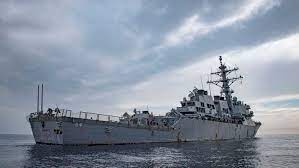The Houthi attacks on commercial shipping in the Red Sea have forced many tanker and container ship operators to reroute voyages via Africa, which has increased travel times, delayed goods delivery, disrupted supply chains, and raised shipping costs.
The disruption to traffic via the Red Sea/Suez Canal route could continue for months and ultimately result in sustained higher freight costs and a shortage of container ships, which are now bound on longer routes via the Cape of Good Horn, analysts say.
The current chaos is likely to continue for weeks—or months—until the shipping and maritime transportation industry settles on a “new normal”.
Until then, the higher freight costs and the delays in deliveries could reignite inflation and make the road to easing interest rates bumpier than central banks thought it would be a month ago.
Red Sea Traffic Diverted
Traffic via the Suez Canal has nosedived since the middle of December, per data from PortWatch, a platform launched by the International Monetary Fund (IMF) in partnership with Oxford University.
The route saw last week the lightest vessel traffic since April 2021, when container carrier Ever Given ran aground in the Suez Canal, blocking shipping in both directions.
Oil tanker traffic has also been impacted by the threat to commercial shipping near the Bab el-Mandeb Strait and the Red Sea, prompting oil majors and top trading houses to divert traffic to the longer route via Africa.
Shell was the latest to halt all shipments via the Red Sea last week. In the middle of December, another UK-based supermajor, BP, temporarily suspended all shipments via the route, “in light of the deteriorating security situation for shipping in the Red Sea.”
Oil shipments out of the Middle East are also being delayed as tankers have turned away from their original route via the Suez Canal. As of January 19, tankers carrying nearly 9 million barrels of oil from Saudi Arabia and Iraq were estimated to be delaying their deliveries as they have diverted away from the Red Sea, and are now headed on the longer route via Africa, Bloomberg vessel-tracking data showed.
The route via the Cape of Good Hope in Africa will increase the voyage time between the Middle East and Europe by about two weeks compared to the Suez Canal route.
Longer Route, Higher Costs
The longer route raises freight rates and ties up tankers and container carriers for longer than originally planned, meaning not only that the customers would receive their goods some two weeks later than anticipated, but also that more vessels would be needed to replace those still shipping oil, fuel, containerized, or frozen goods on the longer routes.
This will strain supply chains and could lead to higher end-product prices, which would fuel inflation just as central banks started to signal rate cuts are in the cards.
Interest rate cuts are coming, the Fed and other central banks continue to say. But those cuts could be delayed by a few months if monetary policymakers see an uptick in inflation.
Europe could be particularly vulnerable to inflation, considering that the Suez Canal is its key maritime trade route from Asia.
Container rates on the most affected Asia-Europe route have more than tripled since December, while the global average has doubled, Rico Luman, senior sector economist at ING, wrote in an analysis earlier this month.
The disruption in maritime trade “leads to short-term mismatches between supply and demand and imbalances in the availability of vessels, personnel, and empty containers, and this needs to balance out again,” Luman said.
Moreover, the Chinese New Year is approaching and vessels are returning to Asia too late compared to initial loading plans, leading to cancellations.
“This will likely impact most of the first quarter and potentially the second quarter as well. For time-sensitive deliveries not yet underway, shippers may opt for shipment through the air, but this is much more expensive,” ING’s Luman added.
All in all, ING reckons that while the Red Sea traffic chaos has created new inefficiencies, trade is unlikely to be derailed, and global merchant trade will grow by 2.5% year-on-year in 2024 compared to a low comparative base of 2023.
In Europe, retailers and automakers have started to feel what executives described to the Financial Times as a “chaotic” period in delivery times.
Due to the Red Sea traffic chaos and the many diversions via Africa, some automakers have temporarily paused production at some plants. These include Tesla in Berlin, Volvo Cars in Gent, Belgium, and Suzuki in Hungary.
A major escalation of the tensions in the Middle East could lead to high oil prices, too, and Europe is closely watching the developments for a potential impact on energy prices and inflation.
“War in the Middle East, and in particular disruptions to shipping, mean that there’s always a danger of an increase in energy prices that would fuel inflation,” Beata Javorcik, Chief Economist at the European Bank for Reconstruction and Development (EBRD), told Euronews Business in Davos last week.
The European Central Bank (ECB) may hold off on any rate cuts this year until it sees a clear path to 2% inflation, Robert Holzmann, ECB Governing Council member, told CNBC last week.
“I cannot imagine that we’ll talk about cuts yet, because we should not talk about it. Everything we have seen in recent weeks points in the opposite direction, so I may even foresee no cut at all this year,” Holzmann told CNBC’s Steve Sedgwick in Davos.

 Iran Energy News Oil, Gas, Petrochemical and Energy Field Specialized Channel
Iran Energy News Oil, Gas, Petrochemical and Energy Field Specialized Channel



